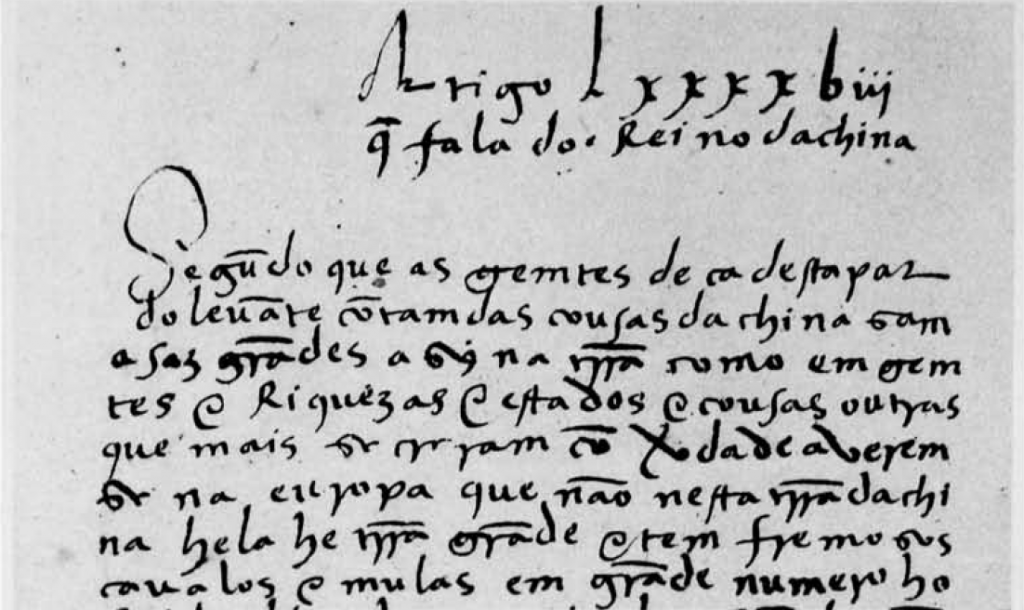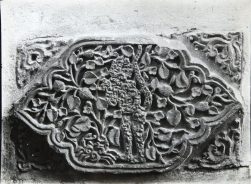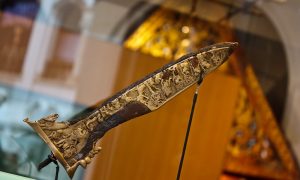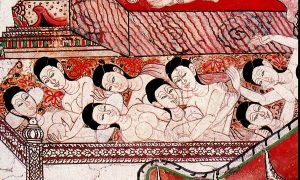The Javanese state that flourished throughout the 14th and 15th centuries is often called the ‘Majapahit Empire’. But was it really an empire, and what does the word ‘empire’ mean in premodern Southeast Asia? This article surveys the evidence that can help us answer these questions. This evidence includes a handful of government inscriptions from east Java, Bali and Sumatra, two Javanese chronicles called the Deśavarṇana and the Pararaton, the official records of the Ming court, and the account of a Portuguese apothecary who visited Java in the early 16th century.
The Shadow of Singhasari (1255–92)
Before Majapahit was established as its new capital in 1293, the kingdom of Java had already begun to exercise its authority on other islands. Majapahit’s predecessor court, Singhasari, had begun to extend its influence beyond Java during the reign of Rājasa (1222–47). According to the Mūla Malurung inscription issued in 1255: ‘His Majesty [Rājasa] served as a single parasol for the world, the whole island of Java as well as the other islands’, the parasol being a common symbol of sovereignty in Southeast Asia and the Indian ocean world.
This rather nebulous assertion of authority was made concrete by a mighty Singhasari king called Kṛtanagara (1268–92). Two chronicle sources pay close attention to Kṛtanagara’s career: the 14th-century Deśavarṇana and the 16th-century Pararaton. Both of them depict Kṛtanagara as a militant ruler whose successful wars against Sumatra (1275) and Bali (1284) brought these regions under his personal dominion. Kṛtanagara was said to be an adept of Tantric practices, many of them aimed at boosting his supernatural powers. The Deśavarṇana describes his military victory over the Sumatran kingdom of Malayu as being ‘a result of his divine manifestation’ (41.5d).
Kṛtanagara’s success in subjugating various kings outside Java is illustrated by the Padang Roco inscription in central Sumatra (issued in 1286), which refers to him as the ‘great king of kings’ (mahārājādhirāja). He was apparently the overlord of the Sumatran king Maulivarmadeva, who in this inscription is merely a ‘great king’ (mahārāja). Historians today suspect that Kṛtanagara’s disruption of the power balances in the archipelago earned him the enmity of Kublai Khan, the Yuan Emperor in China.
These sources show that the Javanese king Kṛtanagara had been recognised as the overlord of certain kings on other islands in the late 13th century. The legacy of Kṛtanagara’s expansionist policies would be taken up by his Majapahit successors in the 14th century.
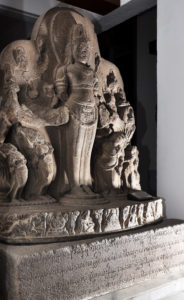 The Padang Roco inscription (National Museum of Indonesia D.198-6468)
The Padang Roco inscription (National Museum of Indonesia D.198-6468)
Majapahit’s Modest Beginnings (1293–1309)
Majapahit became the capital of Java in 1293, after a convoluted power struggle between several Javanese factions, an army from the neighbouring island of Madura, and even an expedition sent from China by the Khan. The eventual victor was a new king called Vijaya, who cut a rather less impressive figure than his predecessor Kṛtanagara.
The Kudadu inscription (issued in 1294) claims that Vijaya is simply ‘the lord of the whole island of Java’ (1b). The Sukhāmṛta inscription, issued two years later, again describes Vijaya as ‘the lord of all Java’, but more importantly, it describes Kṛtanagara as having once been ‘the king of the kings of Java, extending as far as the kings of the other islands’ (6b.2). The difference is clear. Kṛtanagara was the conqueror who defeated and ruled over foreign kings, while Vijaya controlled only Java.
The Balawi inscription (issued in 1305) describes Vijaya as ‘the sole ruler of the whole of the circle of Java’ and ‘the one whose throne is ornamented by the hair of the kings of the outer islands’ (1b.5). In this inscription, Vijaya compares his four wives (Kṛtanagara’s daughters) to four islands: ‘in their character they are just like Bali, Malayu, Madura, and Tanjung Pura’ (2a.2). We know from the usage in the later Deśavarṇana that Malayu is being used here as shorthand for the island of Sumatra, and Tanjung Pura for Borneo. The Balawi inscription also reiterates the fact that it was Kṛtanagara, not Vijaya, who ‘had his lotus feet kissed’ by kings of the other islands, ‘especially by the king of Bali’ (2a.4).
The shadow of Singhasari loomed large over the first Majapahit king. We see from these inscriptions that Vijaya’s own claim to sovereignty over the other islands was vague, and that he preferred to look back to the imposing precedent set by Kṛtanagara’s overseas campaigns.
We also know that Vijaya’s claim to rule ‘all of Java’ was an exaggeration. The later historical sources (Pararaton, Rangga Lawe and Sorāndaka) narrate how Vijaya spent most of his reign trying to deal with uprisings by his former comrades who had become dissatisfied with his leadership. Shortly after 1300, the king was forced to give up half of his Javanese territory to a Madura-based ruler called Vīrarāja, an erstwhile ally who had helped to put him on the throne in the first place. Vijaya died in 1309, with much of his own kingdom in open rebellion against him, having no real capacity to continue Kṛtanagara’s imperialist agenda in the archipelago.
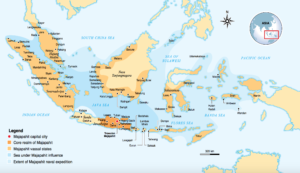 Map of areas influenced by Majapahit, showing the different grades of Javanese power (created by Gunawan Kartapranata 2009)
Map of areas influenced by Majapahit, showing the different grades of Javanese power (created by Gunawan Kartapranata 2009)
Consolidating the Heartland (1309–28)
Vijaya’s successor Jayanagara spent the years between 1309 and 1323 dealing with the challenges to Majapahit authority in Java itself. Little is known about Java’s relationship with other islands during this time. The next important piece of evidence for our inquiry is the Tuhañaru inscription (issued in 1323), which describes ‘the whole span of the island of Java, with its dependencies the islands of Madura, Tanjung Pura et cetera, which produces the effort and sacrifice of all people, who constantly pay homage to and worship the King’ (4a.3). This inscription articulates the relationship between Java and other islands as one of ‘dependency’ involving obedience and homage to the Majapahit king. But it is still worryingly vague on which islands were included among these dependencies. Who exactly fell into the category of ‘et cetera’?
The chronicles show that Jayanagara’s reign was mostly preoccupied with domesticating eastern Java under Majapahit rule, a task he had largely completed by his early death in 1328. As the young king slowly consolidated Majapahit’s grip on the Javanese heartland, he became confident enough to start calling himself a ‘king of kings’ of Sumatra, Borneo, Madura and Bali, just as Kṛtanagara had done and Vijaya had not. What did Jayanagara’s claims of overlordship mean in practice? As yet, we have no evidence of specific military or diplomatic actions taken by the Majapahit court to enforce its theoretical sovereignty over the other islands.
One Oath To Rule Them All (1331–57)
Things changed drastically when a queen called Gitārja and her prime minister Gajah Mada took control of Majapahit in 1329. According to the Pararaton (p. 28), Gajah Mada swore an oath in 1331 to ‘defeat the outer islands: Gurun, Seran, Tañjung Pura, Haru, Pahang, Ḍompo, Bali, Suṇḍa, Palembang, Tumasik’. This is the famous Palapa Oath that Indonesian schoolchildren learn about. It is often paraphrased in Indonesian as a promise to ‘unite the archipelago’ (menyatukan tanah air), but that is not an accurate translation, because the Old Javanese text simply means ‘the other islands are defeated’ (kālah nūṣāntara). The places mentioned in the oath are very far-flung: Pahang is on the Malaysian peninsula, while Ḍompo is on the island of Sumbawa.
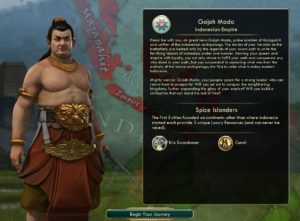 Loading scene from the game Civilization V depicting Gajah Mada’s conquest of the archipelago
Loading scene from the game Civilization V depicting Gajah Mada’s conquest of the archipelago
The Pararaton was compiled sometime in early 16th century, so it is not a contemporary source for Gajah Mada’s oath. We can’t know whether he really said such a thing. But the list of military targets in the oath matches closely the list of tributaries claimed by Majapahit in the Deśavarṇana. An interesting detail given in the Pararaton is that when Gajah Mada made this oath, the other ministers laughed in his face. Even if this is just a creative embellishment, it illustrates how extravagant the project must have sounded to his contemporaries.
We know that Gajah Mada’s words were followed up with action. The Deśavarṇana (49.4a) states that Java attacked Bali in 1343 and deposed its monarch. North Sumatran inscriptions and chronicles suggest that the same thing happened at Pasai shortly before 1345. Javanese foreign policy during the 1330s and 1340s seems to have consisted of something like this:
1) demand obedience and tribute from kings on other islands,
2) launch a military strike on those who refused the demand,
3) replace them with rulers who would be more loyal,
4) withdraw the military force until the next time it was needed.
From what we can tell from the chronicles, Gajah Mada’s military campaigns were more successful and wide-ranging than those of Kṛtanagara. Majapahit’s overseas power had finally eclipsed that of Singhasari.
In Praise of the Majapahit Emperor (1365)
The definitive claim of Majapahit dominance over the archipelago is found in the Deśavarṇana. This text is a blend of chronicle, royalist propaganda, and personal memoir, written by a Buddhist cleric in 1365. The poem dedicates Cantos 12–16 to listing the overseas dependencies claimed by Java at the time. The Majapahit court is compared to the sun and moon, while the subordinate courts in Java and ‘all the peripheral countries on the other islands’ are like planets; they ‘seek shelter in and humbly approach’ the king (12.6).
Cantos 13–14 name these peripheral countries and group them into four: the Sumatran countries that ‘are dependent on’ Malayu, the Borneo countries dependent on Tanjung Pura, the Malay peninsula countries dependent on Pahang, and the miscellaneous countries to the east. The places mentioned go as far north as Langkasuka (modern-day Pattani), as far west as Lamuri (Aceh), and as far east as Wwanin (generally thought to be somewhere on the coast of West Papua). An extremely extensive area.
All these regions described as ‘being protected’ (15.1a), ‘paying homage’ (15.3a), ‘bringing gifts that appear every month’ (15.3b), ‘being guarded’ (16.5a), and ‘obedient to all the commands’ (16.5b) of the Javanese king. Majapahit’s method of enforcing this obedience is explained: ‘any that transgressed his commands was attacked and wiped out completely by groups of naval officers, who are variously decorated’ (16.5c–d).
When the other countries did comply with Majapahit’s demand for tribute, Javanese scholars and officers were sent specially to collect the tribute from these places (15.3). There is a statement that religious scholars were sent in order to ‘establish the doctrine’ of Śiva and Buddha in the outer islands, ‘so that there would not be deviation’ (16.1). Does this suggest a sort of religious domination too?
The Deśavarṇana is a dependable eyewitness account of the times, but its main purpose is to flatter the Majapahit king. How seriously can we take its enormous list of countries that were supposedly ‘obedient to all the commands’ of Java?
Ādityavarman’s Autonomy (1347–75)
There are some holes in the Deśavarṇana’s story of Majapahit supremacy. Enter Ādityavarman, a Javanese prince with possible Malay lineage who served as senior minister at Majapahit in the 1330s and early 1340s, apparently outranking Gajah Mada himself during this period. According to an inscription written on a statue of Manjuśrī dated 1343, Ādityavarman was a Buddhist and was a descendant of Kṛtanagara.
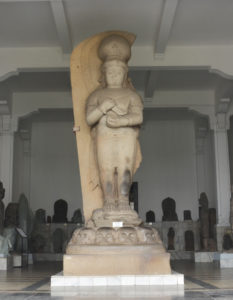 A gigantic Bhairava statue believed to represent Ādityavarman (National Museum of Indonesia, No. Inv. 6470)
A gigantic Bhairava statue believed to represent Ādityavarman (National Museum of Indonesia, No. Inv. 6470)
After years of service to Majapahit, Ādityavarman did something odd in 1347. He suddenly appeared in central Sumatra declaring himself the ‘great king of kings’, precisely the title Kṛtanagara had used as overlord of that region in 1286. Ādityavarman continued to issue inscriptions in Sumatra on his own authority up until 1375, apparently not acknowledging any loyalty to Java. During this time, he claimed descent from the old Sumatran Mauli dynasty, whom Kṛtanagara had subjugated back in 1275. One of Ādityavarman’s major inscriptions, the Amoghapaśa inscription (1347), is written on the back of a statue dedicated by Kṛtanagara in 1286. And just like Kṛtanagara, Ādityavarman was also interested in Tantric rituals to concentrate his mystical power.
The Deśavarṇana completely ignores Ādityavarman’s claims of autonomy. Instead it reports that his kingdom paid tribute to Majapahit, just like all the other countries in Sumatra. This discrepancy shows that the Deśavarṇana is prone to exaggerating the extent of Java’s hegemony, just as we saw in the inscriptions of Vijaya and Jayanagara in the early 14th century. It means that we can’t take its list of tributaries at face value, but neither can we reject the text’s claims completely.
The Massacre of the Sundanese (1357)
The massacre of the Sundanese, often referred to as the Bubat War, shows another side to Java’s strategy of domination. It is important to note before we start this section that the Majapahit sources almost always list Sunda as one of the ‘other islands’ and not a part of the island of Java. This confirms our impression that when Majapahit documents say ‘Java’, they mean only ‘where the Javanese speakers live’, i.e. central and east Java, whereas ‘Sunda’ means ‘where the Sundanese speakers live’, i.e. west Java.
According to the Pararaton (pp. 28–9), the Sundanese royal family was invited to Majapahit in 1357. They had come to attend a wedding between a Sundanese princess and the Javanese king Hayam Wuruk. Instead they were ambushed and killed by their Javanese hosts. The pretext for this massacre was a miscommunication: the Sundanese had come on the impression that Hayam Wuruk would take the Sundanese princess as his primary wife and acknowledge the equal status of the Sundanese dynasty to that of Majapahit, while the Javanese assumed the princess was being offered as tribute and would have concubine status.
The decision to kill the Sundanese was taken by Gajah Mada and the king’s uncle Kudāmṛta. Gajah Mada evidently viewed the destruction of the Sundanese royal family as fulfilling his promise to ‘defeat Sunda’. After the massacre, he declared that the Palapa Oath was a mission accomplished.
This story is found in the later Javanese sources Pararaton, Kidung Sunda, and Tatwa Sunda, and is also mentioned briefly in the Sundanese history Carita Parahyangan. Strangely, it is absent from all the 14th-century primary sources, such the Deśavarṇana and the inscriptions. Nevertheless, it is an integral part of the story of Gajah Mada’s oath to defeat the kingdoms of the archipelago. The incident shows that Majapahit supremacy was not easily accepted by other kingdoms, but remained an ongoing source of conflict throughout the 14th century.
The Character of Javanese Hegemony
How did Majapahit actually assert its dominance in the mid 14th century? It is plausible that Java could make long-distance naval strikes against other islands in the archipelago, as described in the Deśavarṇana. It is also likely that those countries sent tribute to Majapahit as a formal acknowledgement of superiority. But Java did not annex those countries, which are always called ‘other islands’ separate to Java. Madura was the only significant island ‘not included among the overseas palaces’, but rather, it was administratively ‘united with the land of Java’ (Deśavarṇana 15.2).
Bali was another somewhat special case. According to later Balinese tradition, Javanese nobles were sent to administer the island after the Majapahit invasion of 1343. The Batur inscription, issued in north Bali in 1384, records that a dispute between one of these nobles and a local community of blacksmiths was referred to the Majapahit court for adjudication.
The Javanese also had the final say in matters pertaining to southern Sumatra. In 1397 the Ming court in China was having difficulties with the Sumatran country they called San-fo-qi, and asked the Javanese to settle the matter because ‘San-fo-qi is subject to Java’ (Ming Shi-lu, 18 September 1397). This is further evidence for the Majapahit court being acknowledged as the highest political authority in this central part of the Indonesian archipelago.
The Majapahit rulers preferred to install obedient local rulers in distant islands, rather than administering them directly. They were sometimes asked to intervene in some domestic problem, suggesting the Majapahit court was seen as having overall responsibility for settling disputes in the region. When these local rulers asserted their autonomy, such as at Pasai and in Bali in the 1340s, or at Palembang in the 1390s, the Javanese deposed them and put in someone they liked better. But this was not always possible. Ādityavarman in central Sumatra seems to have been able to avoid any punishment for defying Majapahit, and it was only after his death in 1375 that the Javanese attempted to reimpose their authority in his kingdom.
This article explores the life and career of one of Java's great premodern leaders: the 16th-century queen of Jepara.
Java’s Muslim Warrior Queen
Memories of Majapahit
The Malay regions preserved traditions about Majapahit domination for a long time. Between 1513 and 1515, the Portuguese apothecary Tomé Pires recorded oral histories about the foundation of Melaka, the leading Malay kingdom at the turn of the 16th century. Pires’ notes were compiled in a document called the Suma Oriental, which has proved an invaluable source for the history of Southeast Asia in this period.
Pires’ sources claimed that around 1400, a Majapahit king called ‘Batara Tamarill’ had as his vassals the kings of Palembang and of Singapore. The son of the Palembang king married into the Majapahit royal family, but ‘when he realised how nobly he was married and how great was his power in the neighbouring islands which were under his brother-in-law’s jurisdiction, he rose against the vassalage and obedience’ (Pires, p. 231). The king of Majapahit sent a punishing expedition that took control of the island of Bangka and then drove his disobedient vassal out of Palembang and forced him to flee to Singapore, after which he ended up founding the Melaka kingdom. This event shows that as late as 1397, Majapahit was still effectively able to enforce its claims over its overseas dependencies.
But the evidence for Javanese hegemony peters out in the 15th century. The Javanese kings continued to refer to themselves as ‘king of kings’ in inscriptions dated 1447, 1473 and 1486, but they no longer talked about the other islands specifically. No further military adventures are mentioned in the chronicles. In the latter half of the 15th century, Javanese shipping slowly passed out of Majapahit’s control and into the hands of the autonomous Muslim-ruled towns on the north coast of Java.
Pires was told that Java ‘used to rule as far as the Moluccas and over a great part of the west, and … almost all of Sumatra, until about a hundred years ago [i.e. until the 1410s], when its power began to diminish’ (p. 174). This account is broadly consistent with what we know from the other sources about Majapahit’s claims of hegemony in the period 1330–1400 and its apparent weakening in the 15th century.
 The Lisbon manuscript of Pires’ Suma Oriental
The Lisbon manuscript of Pires’ Suma Oriental
What’s in an Empire?
After all this, can we say that Majapahit was really an empire? The answer depends on what we mean by the word. If being an empire means the direct administration of provinces, permanent military occupation, and the imposition of political and cultural norms over a wide area, then Majapahit was probably not an empire. Javanese rule over the other islands was too intermittent and too indirect to qualify by those criteria.
But if being an empire means the projection of military power at will, formal acknowledgement of overlordship by vassals and third parties, and the regular delivery of tribute to the centre, then Java’s relationship to the archipelago can well be considered an imperial one, especially during the late Singhasari (1268–92) and middle Majapahit (1330–1400) periods. At other times, such as early Majapahit period (1293–1330) and the late Majapahit period (after 1400), the Javanese dream of an overseas empire is much less credible.
 Facebook
Facebook  Twitter
Twitter  Soundcloud
Soundcloud  Youtube
Youtube  Rss
Rss 